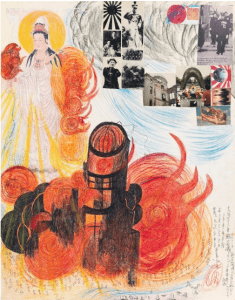Maki Kaneko, PhD., Associate Professor, The Kress Foundation Department of Art History, University of Kansas
“Inter-Imperial (Bri)Collage”: Jimmy Tsutomu Mirikitani’s Visualization of Incarceration, Hiroshima and New York City
Discussant: Chelsea Foxwell, PhD., Associate Professor of Art History and the College, Department of Art History
Friday, June 5, 2020
4:30-6:30 pm (CT), Zoom meeting (please find the registration link below)
Abstract: This presentation focuses on the artist Jimmy Tsutomu Mirikitani (1920-2012) and explores how his collage-drawings pose a challenge to the normative mode of history writing. Mirikitani was born in Sacramento, California, raised in and trained as a painter in Hiroshima, Japan, and returned to the U.S. at age eighteen. During the Pacific War, Mirikitani was incarcerated and forced to renounce his U.S. citizenship. From the late 1980s, Mirikitani, without acknowledgment of his reinstated U.S. citizenship, lived and made his art on the streets of New York City to survive as well as keep his memories alive. Mirikitani’s interstitial identity as a kibei (the Japanese Americans educated in Japan) and long-term stateless person, trans-Pacific trajectories, and street life in NYC largely shaped his signature art form and practice: a mélange of Nihonga (traditionalist-style Japanese painting) and photo-collage made out of cast-off materials. These works were also created through ad-hoc collaborations with the NYC neighbors and pedestrians who provided the artist with necessary tools or labor. Through this highly entangled art form and unconventional working method, the artist made a bold claim about his legitimate position within mainstream US-Japan history as well as the post-1945 NY art community. Given his improvised method of collaboration and interstitial identity, I propose to analyze Mirikitani’s collaged works through the two critical conceptual lenses of “bricolage” and “inter-imperiality.” This study thereby considers the radical potentials of Mirikitani’s art which invites us to reimagine the histories beyond the rigid fixities of nation-state and identitarian politics.
Jimmy Tsutomu Mirikitani, Untitled (Hiroshima), ca. 2001.
Zoom Registration Link: https://uchicago.zoom.us/meeting/register/u50sdO6gqD4jTkGL5pvMOEX3RSVI9Fcepg
This event is co-sponsored by the Center for East Asian Studies at the University of Chicago.
++++++++++++++++++++++++++++
Maki Kaneko is an Associate Professor in the Kress Foundation Department of Art History at the University of Kansas, where she researches and teaches modern and contemporary Japanese visual arts and the art of Asian Americans and the Asian diaspora. Her publications include the single-authored book Mirroring the Japanese Empire: The Male Figure in Yoga Painting, 1930-1950 (Brill, 2015) and the co-edited volume “Modern & Contemporary East Asian Art,” special issue, Spencer Museum of Art The Register VIII, no. 5 (2019). She also has published the book chapter “Japanese Modern Art History in North America and the Perspective of Asian American Art Studies,” in Taniguchi Fumie Studies (Toyonaka: Ryūshidō, 2018), “War Heroes of Modern Japan: Early 1930s War Fever and the Three Brave Bombers,” in Conflicts of Interest: The Art of War in Modern Japan (St. Louis: St. Louis Art Museum, 2016), and the journal article “New Art Collectives in the Service of the War: The Formation of Art Organizations During the Asia-Pacific War, 1937-1945,” Positions: East Asia Cultures Critique 21, no. 2 (Spring 2013). Kaneko is currently working on a book-length study of and an exhibition on Jimmy Tsutomu Mirikitani and Japanese and Japanese American artists in the post-9/11 era.
Chelsea Foxwell’s scholarship ranges from the medieval through modern periods of Japanese art with special emphasis on the 19th and 20th centuries. She is the author of Making Modern Japanese-Style Painting: Kano Hōgai and the Search for Images (2015). In 2012 she co-curated the exhibition Awash in Color: French and Japanese Prints with Anne Leonard at the Smart Museum of Art. Her work focuses on Japan’s artistic interactions with the rest of East Asia and beyond, nihonga and yōga (Japanese oil painting); “export art” and the world’s fairs; practices of image circulation, exhibition, and display; and the relationship between image-making and the kabuki theater. A member of the Committee on Japanese Studies and the Center for the Art of East Asia, she is a contributor to the Digital Scrolling Paintings and the Reading Kuzushiji projects.
